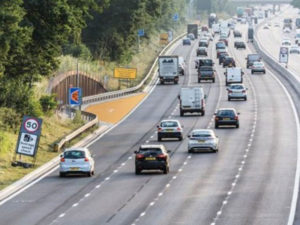Bright orange emergency refuge area trialled for smart motorways
A bright orange emergency refuge area is being trialled on the M3 smart motorway in Surrey to see if it can improve driver awareness of what do to in an emergency.

Improved visibilty: the bright orange SOS-signed emergency refuge area on the M3.
According to recent RAC research, although smart motorways are becoming increasingly common across the UK, 52% of drivers don’t know what an emergency refuge area (ERA) on a smart motorway is or that they should use them in the event of a breakdown or an accident in the absence of a hard shoulder. And a survey of over 20,000 drivers published by the AA last year found eight out of 10 think that axing the hard shoulder has made motorways more dangerous than four years.
Now, two weeks after the M3 smart motorway went live, Highways England has launched a redesigned emergency area that uses a bright orange road surface and along with clearer signs on where to stop, additional distance markers between ERAs, and better signage that uses the SOS acronym – the new features are intended to make it more obvious to drivers on smart motorways while also stopping drivers for using the ERA for anything other than an emergency.
The trial – part of an ongoing review into the design and spacing of emergency areas on smart motorways that is due to report in the autumn – could be rolled out across the smart motorway network if it proves successful and is being backed by Highways England’s ongoing national TV, radio and social media campaign covering key themes such as not driving in lanes closed by Red X signs and how to stop in an emergency.
The RAC greeted the trial but road safety spokesman Pete Williams added: “We remain concerned about the long distances between ERAs on many smart motorways where the hard shoulder has been permanently removed and believe that safety would be further enhanced by additional ERAs to reduce the likelihood of vehicles being stranded in live lanes.”















